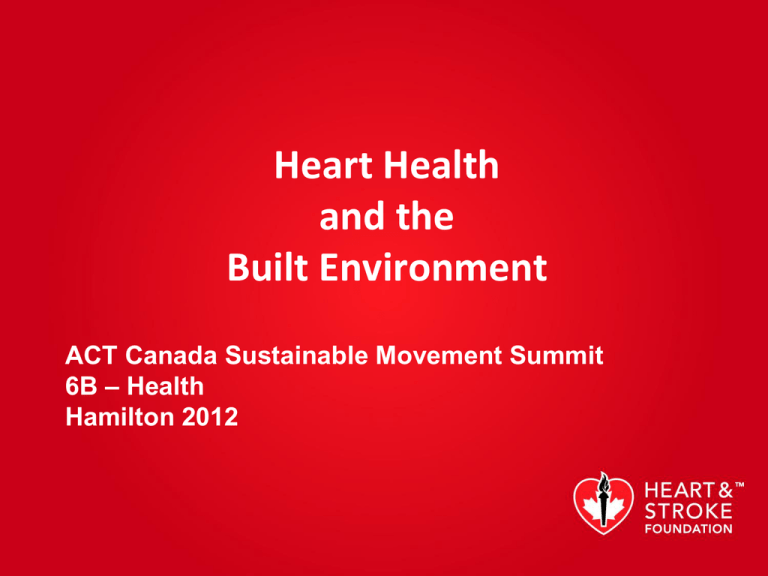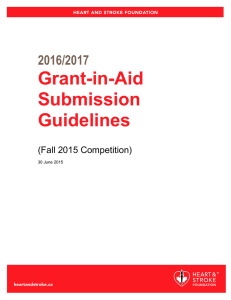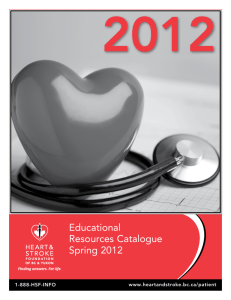1. Sam AbiSaab
advertisement

Heart Health and the Built Environment ACT Canada Sustainable Movement Summit 6B – Health Hamilton 2012 What we will cover today? Heart disease and stroke: Facts and risk factors The built environment and heart health – building the case Heart and Stroke Foundation – investing in healthy BE Healthy Community Design Research Healthy Canada by Design Shaping Healthy, Active Communities Health Promotion Specialists Team - Ontario Facts and Risk Factors The most recent Canadian Health Measures Survey found that only 15% of Canadian adults 1 and 7% of Canadian children 2 and youth get the recommended amount of physical activity Across Canada, only about 12% of trips to the grocery store, work, the library or school are made on foot or by bicycle, compared to 46% in the Netherlands and 41% in Denmark 3 Safety concerns keep 1 in 5 Canadians from walking or bicycling 4 1- Active Healthy Kids Canada Report Card on Physical Activity for Children and Youth, 2011: 17.13 July 2011 2- Colley RC, Garriguet D, Janssen I, Craig CL, Clarke J, and Tremblay MS, Physical activity of Canadian Adults: Accelerometer results from 2007 to 2009 Canadian Health Measures Survey. 3- Pucher J, Dijkstra L. Promoting safe walking and cycling to improve public health; lessons from the Netherlands and Germany. Am Journal of Public Health 2003; 93(9): 1509-1515 4- Canadian Institute of Health Information. Improving the Health of Canadians: An introduction to health in urban places. 2006. Building the Case Understanding the connection between health and community design will lead to improved policy, improved community environments and improved health A recent study compared rates of active transportation with obesity in Europe, North America and Australia and found that generally, the countries with higher rates of active transportation had lower rates of obesity. 5 5- Basset DR, Pucher J, Buehler R, Thompson DR, Crouter SE. Walking, Cycling, and Obesity Rates in Europe, North America and Australia. Journal of Physical Activity and Health 2008, 5, 795-814 Building the Case The risk of obesity has been shown to decline by 4.8% for each additional kilometre walked and can increase by 6% for each hour spent in a car per day . 6 A recent study found that for every 5% improvement in the walkability of a neighbourhood, adults who reside there tend to walk and cycle 32% more, have a lower body mass index and enjoy reduced pollution from automobiles.7 6- Frank, L et al. Obesity Relationship with Community Design, Physical Activity, and Time Spent in Cars. American Journal of Preventive Medicine 2004; 27: 87-95. 7- 1Lawrence D. Frank et al. (2006). “Many Pathways from Land Use to Health: Associations between Neighbourhood Walkability and ActiveTransportation, Body Mass Index, and Air Quality.” Journal of the American Planning Association, Volume 72, Issue 1, p. 75-87 Healthy Community Design Research Since 2009, The Heart and Stroke Foundation (HSF) and the Canadian Institute for Health Research (CIHR) partnered to support several, multi-year community projects linking firstclass researchers with policy makers to: Address the information and policy gaps Identify evidence-based ways to improve community design to support healthy living Healthy Community Design Research QUALITY (Qébec A dipose and L ifestyle I nves T igation in Y outh) Features of the built environment in residential neighbourhoods that influence excess weight and weight-related behaviors in a cohort of children at risk of obesity (http://www.etudequalitystudy.ca/ ) BEEP (Built Environment Edmonton Project) A longitudinal examination of the relationship between the built environment, physical activity, and social factors within the Capital Health Region of Alberta (http://www.ualberta.ca/~tanyab/BEEP%20report.pdf ) Healthy Community Design Research BEAT (Built Environment and Active Transportation) - UBC How to increase active school transport and specifically, the role of the built environment in shaping this behavior NEWPATH (http://health-design.spph.ubc.ca/research/newpath/ ) is an innovative, trans-disciplinary research program focused on evaluating how different urban built environments impact a variety of quality of life factors, including; physical activity, diet, access to food, air pollution, and greenhouse gas emissions. The project’s study area is the Region of Waterloo, a regional municipality located in southcentral Ontario. Healthy Canada by Design CLASP—Overview Healthy Canada by Design CLASP—Overview Through Healthy Canada By Design-CLASP, seven coalitions have been funded to integrate and build upon their practices to prevent chronic diseases What is this initiative’s vision? Health officials, planners, engineers, and NGOs in communities across Canada collaborate seamlessly to ensure built environments are designed to promote health and well being, thus contributing to the reduction of risk factors for chronic diseases. Tools overview Tools overview Three major websites: • Heart and Stroke Foundation's: www.heartandstroke.ca/healthycommunities • Urban Public Health Network’s: www.healthycanadabydesign.ca • Canadian Institute of Planners: www.cip-icu.ca/health Tools overview www.heartandstroke.ca/healthycommunities Tools overview • Heart and Stroke Foundation's: www.heartandstroke.ca/healthycommunities Shaping Health, Active Communities Workshop in Action Parry Sound - Ontario Parry Sound Active Transportation Committee Knowledge sharing Active Transportation Charter Active Transportation Master Plan Campaign “The workshop really helped define what the issues are in Parry Sound, and to present active transportation as a solution to the concerns of various groups in the community. It enabled and inspired us to aim bigger” Joel Kirk, a local resident Shaping Health, Active Communities Workshop in Action Nova Scotia Heart&Stroke Walkabout Influencing government policy 3 workshops in 3 months and more are planned Invited by a coalition of partners responsible to submit a response to the five year regional planning review Proclamation of June as Active Transportation month by the Nova Scotia government Government funding for Walkabout program to support local active transportation events in June “Because walking is so influenced by government policy – at all levels – it’s important to talk about how everything comes together and to show, visually, what a walkable community can look like” Joel Kirk, a local resident Christine MacLeod, a HSF staff Next steps We just started Phase 2 of this initiative: • Deepening the impact of the tools and promising practices developed to date in Ontario, BC and Quebec, who led Phase 1 (October 20009 to Sept 2012). • Broadening the impact of the tools and insights generated in Phase 1 by assisting seven new health regions in seven provinces in working with planners, engineers and NGOs on land use and transportation policy development. Project scheduled to be completed Sept 2014. HSF – Health Promotion Specialists Team 14 Health Promotions Specialists in Ontario assigned to geographical areas Deliver and support advocacy and other health promotion activities Build and maintain relationship with community partners HSF Advocacy Initiatives Heart Healthy Children and Youth: Address the issue of childhood obesity and advocate for increasing opportunities for physical activity and healthy eating for Ontario children Resuscitation Diversity HSF – Health Promotion Specialists Team Thank you! Sam AbiSaab Health Promotion Specialist & BE Lead Heart and Stroke Foundation sabisaab@hsf.on.ca











